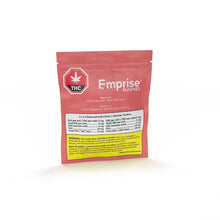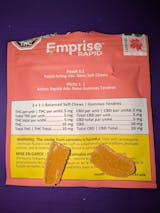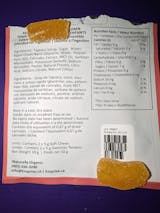About Peach 1:1 Soft Chews
Emprise's rapid onset Peach 1:1 Soft Chews are a THC:CBD 5:5 balanced formulation that is active in 8-12 minutes using Emprise's advanced nano-THC technology.
Ingredients: Tapioca Syrup, Sugar, Water, Rapid Onset Nano (Glycerin, Water, Polysorbate (60), Cannabis Extract, MCT Oil, Sorbitan Monooleate, Citric Acid, Potassium Sorbate, Sodium Benzoate), Pectin, Natural Flavors, Citric Acid, Sodium Citrate, Natural Colour.
Each Softchew contains 5mg THC & 5mg CBD.
Contains: 2 Softchews - 10mg THC & 10mg CBD
Certificate of Analysis (COA)
DownloadReviews and Q&A
About Emprise Canada
Emprise is an innovative product manufacturing company with a passion for revealing the true potential of cannabis for the betterment of the people. Emprise specializes in the development of cannabis infused softgels, oils, nano technology and sciences, topicals, beverages, and nutraceuticals.
Recommended For You
- Prix normal
- $49.95
- Prix réduit
- $49.95
- Prix normal
-
$59.95 - Prix unitaire
- par
- Prix normal
- $49.95
- Prix réduit
- $49.95
- Prix normal
-
$74.95 - Prix unitaire
- par
- Prix normal
- $19.95
- Prix réduit
- $19.95
- Prix normal
-
- Prix unitaire
- par
- Prix normal
- $19.95
- Prix réduit
- $19.95
- Prix normal
-
- Prix unitaire
- par
- Prix normal
- $39.95
- Prix réduit
- $39.95
- Prix normal
-
- Prix unitaire
- par
- Prix normal
- $59.95
- Prix réduit
- $59.95
- Prix normal
-
$74.95 - Prix unitaire
- par
- Prix normal
- $64.95
- Prix réduit
- $64.95
- Prix normal
-
$74.95 - Prix unitaire
- par
- Prix normal
- $74.95
- Prix réduit
- $74.95
- Prix normal
-
- Prix unitaire
- par
- Prix normal
- $44.95
- Prix réduit
- $44.95
- Prix normal
-
- Prix unitaire
- par
- Prix normal
- $39.95
- Prix réduit
- $39.95
- Prix normal
-
- Prix unitaire
- par
- Prix normal
- $29.95
- Prix réduit
- $29.95
- Prix normal
-
$39.95 - Prix unitaire
- par
- Prix normal
- $39.95
- Prix réduit
- $39.95
- Prix normal
-
$44.95 - Prix unitaire
- par
- Le choix d'une sélection entraîne l'actualisation d'une page entière.
- Appuyez sur la touche espace puis sur les touches fléchées pour faire une sélection.























